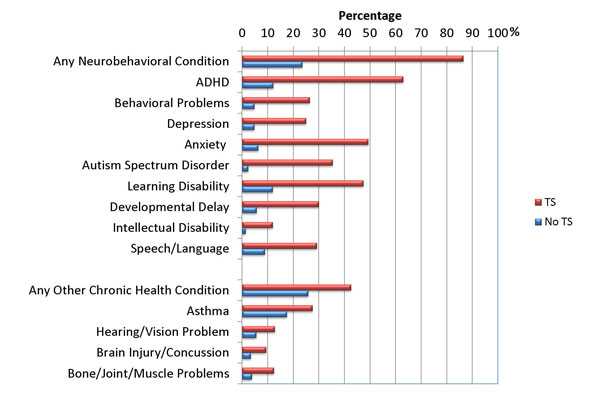Key Findings: A National Profile of Tourette Syndrome
Tourette Syndrome is a condition that affects the nervous system, causing people to make movements and sounds (also known as motor and vocal tics) that they cannot control.

Researchers from the Centers for Disease Control and Prevention used data from the 2011-2012 National Survey of Children’s Health to provide a National Profile of Tourette Syndrome (TS) among US children. The results were published in the Journal of Developmental and Behavioral Pediatrics1. You can read the abstract. See below for a summary of the findings from this article.
Main Study Findings
This paper reports on information from parents of children between 6 and 17 years of age who answered questions about their child’s specific health conditions, neurobehavioral conditions (such as attention-deficit/hyperactivity disorder; ADHD), healthcare needs, indicators of school functioning, and their own level of stress and frustration with parenting, which is characterized as “parenting aggravation.”
The researchers looked at the prevalence of TS among US children, how severe TS is, and how old children were when they were diagnosed. They compared children with and without TS in relation to whether they had other neurobehavioral and chronic health conditions (co-occurring conditions), their healthcare needs, school functioning, and parents’ level of stress and frustration. The impact of co-occurring neurobehavioral conditions in relation to healthcare needs, school problems, and parents’ level of stress and frustration was also explored.
Similar to previous studies, approximately 1 in 360 US children aged 6-17 years ever had TS, based on parents’ report about what their healthcare provider told them. Children with TS were more likely than other children to also have another neurobehavioral condition, a learning disability, or have other chronic health conditions.
Prevalence of co-occurring conditions and disorders among children with TS
Data on 65,540 US children aged 6-17 years from the 2011-2012 National Survey of Children’s Health

Results of the study showed:
- 1 in 360 (approximately 138,000 US children) had ever been diagnosed with TS, based on parent report. This is the same rate as in 2007.
- Parents reported that 1 in 530 US children currently had a TS diagnosis (approximately 95,000 children); most were described as mild (63%, vs. 37% described as moderate or severe).
- The average age of diagnosis of TS was about 8 years.
- Children with TS, compared with those without, were more likely to have
- co-occurring neurobehavioral and other health conditions,
- a special healthcare need,
- received mental health treatment,
- needs for mental health care that were not met,
- parents with high levels of stress and frustration,
- parents who were contacted about school problems.
- Children with TS were less likely to receive effective coordination of care or have a medical home, compared with children without TS.
- When researchers took into account the differences in co-occurring neurobehavioral conditions between children with and without TS, there was no longer any difference in the rate of school problems and unmet mental healthcare needs between children with and without TS. This means that the other neurobehavioral conditions play a larger role than TS alone, in school problems and finding adequate mental health care.
What Do The Findings Mean?
- It is common for children with TS to have other mental health and chronic health conditions.
- TS and co-occurring conditions mean greater healthcare needs, more school problems, and higher parents’ level of stress and frustration.
- The findings support previous recommendations2,3 that it is important to consider co-occurring conditions when diagnosing and treating children with TS.
- Additional information is needed about whether having a medical home and effective coordination of medical care and other services for all these conditions could improve health and functioning for children with TS.
Tourette Syndrome: CDC’s Activities
CDC monitors the number of children who have been diagnosed with TS through the use of national survey data. Including questions about TS on national surveys helps us learn more about the number of children with TS, their use of medical care, and how TS impacts children and their families.
CDC also conducts community-based studies to better understand TS. A recent study looked at how children with TS relate to their family and friends, how they do in school, what kind of health services they use, healthcare and other costs associated with TS, and which factors allow children with TS to succeed. The new Project to Learn about Youth – Mental Health (PLAY-MH) is studying externalizing and internalizing behavior problems and tic disorders in multiple communities to learn more about how many children in a community have one or more mental, behavioral, or emotional disorders, how frequently these disorders appear together, and about any treatment they are receiving.
CDC supports the Tourette and Education Program which is a Public Health Practice and Resource Center. The program provides education for families and healthcare and education professionals, and training on the promising new Comprehensive Behavioral Intervention for Tics (CBIT).
More Information
To learn more about Tourette Syndrome, please visit CDC’s website on Tourette Syndrome and the Tourette Syndrome Association website.
References
- Bitsko, RH, Holbrook, JR, Visser, SN, Mink, JW, Zinner, SH, Ghandour, RM, Blumberg, SJ (2014). A National Profile of Tourette Syndrome, 2011-2012. J Dev Behav Pediatr 35(5), 317-322.
- Cath, D. C., et al. (2011). European clinical guidelines for Tourette syndrome and other tic disorders. Part I: assessment. Eur Child Adolesc Psychiatry 20(4): 155-171.
- Murphy, T. K., et al. (2013). Practice parameter for the assessment and treatment of children and adolescents with tic disorders. J Am Acad Child Adolesc Psychiatry 52(12): 1341-1359.
- Page last reviewed: May 11, 2017
- Page last updated: August 23, 2016
- Content source:


 ShareCompartir
ShareCompartir